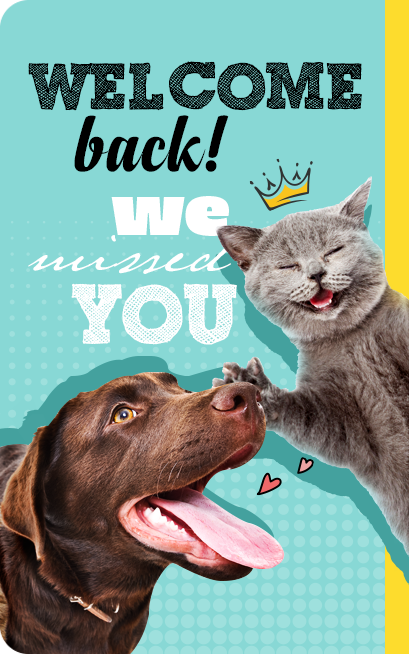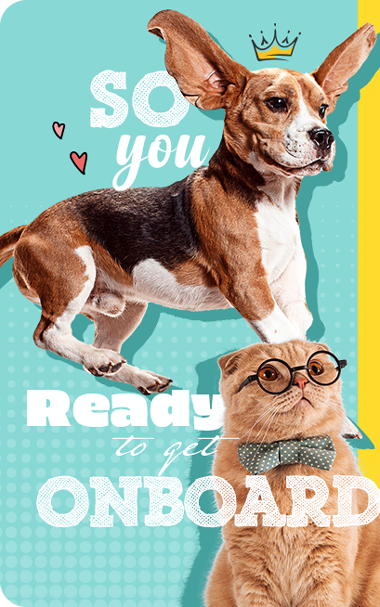Signs That Your Pet Is Happy: A Comprehensive Guide
Posted by Muskan bhardwaj on

Introduction
Understanding the signs of a happy pet is essential for ensuring their well-being and enhancing your bond. Just like humans, pets have their own ways of expressing joy and contentment. Whether you have a dog, cat, or another type of pet, recognizing these signs can help you gauge their happiness and ensure they lead a fulfilling life. This guide explores the various indicators that your pet is feeling happy and content.
1. Signs of a Happy Dog

Dogs are known for their expressive nature, and their happiness is often evident through their behavior and body language. Here are some key signs that your dog is happy:
- Wagging Tail: A wagging tail is one of the most recognizable signs of a happy dog. A tail wagging with enthusiasm, especially when loose and relaxed, indicates that your dog is feeling good. Depending on your dog's personality, the tail might wag in wide, sweeping motions or fast, short bursts.
- Playfulness: Happy dogs are often playful. They may engage in games like fetch, tug-of-war, or simply running around with excitement. If your dog frequently brings you their favorite toy or invites you to play, it’s a sign that they’re enjoying themselves.
- Relaxed Body Language: A relaxed posture is a strong indicator of a happy dog. Look for signs such as a relaxed stance with soft eyes, a loose tail, and an open mouth. If your dog’s body language is relaxed and they seem comfortable, they’re likely feeling content.
- Affectionate Behavior: Dogs that are happy and secure often seek affection from their owners. This can include cuddling, leaning against you, or following you around the house. If your dog enjoys physical contact and shows signs of attachment, it’s a sign that they feel happy and loved.
- Healthy Appetite: A happy dog typically has a good appetite. They will show enthusiasm for mealtime and eat their food eagerly. If your dog maintains a healthy appetite and enjoys their meals, it’s a positive indicator of their overall well-being.
- Energetic Behavior: When dogs are happy, they tend to have plenty of energy. They may exhibit bursts of activity, such as running around, jumping, or playing. This energy is often a sign that your dog is feeling good and enjoys their environment.
2. Signs of a Happy Cat

Cats may not be as overt in their expressions of happiness as dogs, but they have their subtle ways of showing contentment. Here are some signs that your cat is happy:
- Purring: One of the most common signs of a happy cat is purring. Cats purr when they are content and relaxed, often when they are being petted or snuggled. The sound of purring is a reassuring indication that your cat is feeling good.
- Playfulness: Happy cats are often playful and curious. They may engage with toys, chase after laser pointers, or playfully pounce on objects. If your cat shows interest in playtime and is active, it’s a sign of their happiness.
- Relaxed Posture: A content cat will have a relaxed body posture. This includes lying down with their paws tucked under them, stretching out comfortably, or curling up in a cozy spot. A relaxed tail and ears are also indicators that your cat is at ease.
- Slow Blinking: Cats often show their trust and contentment through slow blinking. When your cat looks at you and slowly closes their eyes, it’s a sign that they feel safe and comfortable around you. You can return the gesture to strengthen your bond.
- Affectionate Behavior: Happy cats will often seek out affection from their owners. This can include rubbing against you, kneading with their paws, or following you around the house. If your cat enjoys being close to you and shows affection, it’s a positive sign.
- Grooming: A happy cat will groom themselves regularly. If your cat is clean and well-groomed, it indicates that they are feeling good and are in a comfortable state. Cats who are stressed or unhappy may neglect their grooming habits.
3. Signs of a Happy Small Pet (Hamsters, Guinea Pigs, etc.)

Small pets like hamsters, guinea pigs, and rabbits also have their ways of showing happiness. Here are some signs to look for:
- Active Behavior: Small pets that are happy are typically active and curious. They may explore their environment, play with toys, or interact with you. If your small pet is energetic and engaging in normal behaviors, it’s a sign that they’re feeling good.
- Healthy Eating Habits: A happy small pet will have a healthy appetite. They will eat their food regularly and show interest in their diet. If your pet is eating well and maintaining a healthy weight, it’s a positive sign of their well-being.
- Comfortable Sleeping: Small pets that are happy will sleep comfortably in their bedding or nest. They will curl up in a cozy spot and seem relaxed during their rest periods. A well-rested pet is usually a happy and healthy one.
- Interactive Behavior: Happy small pets will interact with their environment and with you. They may respond to your voice, come to the front of their cage when you approach, or show curiosity about new toys or objects. This interaction indicates that they are comfortable and content.
4. Creating a Happy Environment for Your Pet

Ensuring your pet’s happiness involves more than just recognizing signs of joy. It’s important to create an environment that promotes their well-being and happiness. Here are some tips for fostering a happy and healthy environment for your pet:
- Provide a Balanced Diet: Ensure that your pet receives a balanced and nutritious diet appropriate for their species, age, and health needs. Consult your vet for recommendations on the best food for your pet.
- Regular Exercise: Engage your pet in regular physical activity to keep them healthy and happy. For dogs, this means daily walks and playtime, while cats may benefit from interactive toys and climbing structures.
- Mental Stimulation: Offer mental stimulation through toys, puzzles, and enrichment activities. This helps keep your pet engaged and prevents boredom.
- Comfortable Living Space: Create a comfortable and safe living space for your pet. Ensure they have a cozy bed, clean bedding, and a suitable environment for their needs.
- Routine Veterinary Care: Regular check-ups with a veterinarian help ensure that your pet is healthy and address any potential issues before they become serious.
- Affection and Bonding: Spend quality time with your pet, offering affection, attention, and companionship. Building a strong bond with your pet enhances their overall happiness and well-being.

Conclusion
Recognizing the signs of a happy pet is essential for ensuring their well-being and strengthening your bond. Whether you have a dog, cat, or small pet, understanding their unique ways of expressing joy can help you provide the best care and support for their happiness. By paying attention to their behavior, body language, and interactions, you can ensure that your pet lives a fulfilling and contented life. Creating a positive environment and addressing their physical and emotional needs will contribute to their overall happiness and health.






